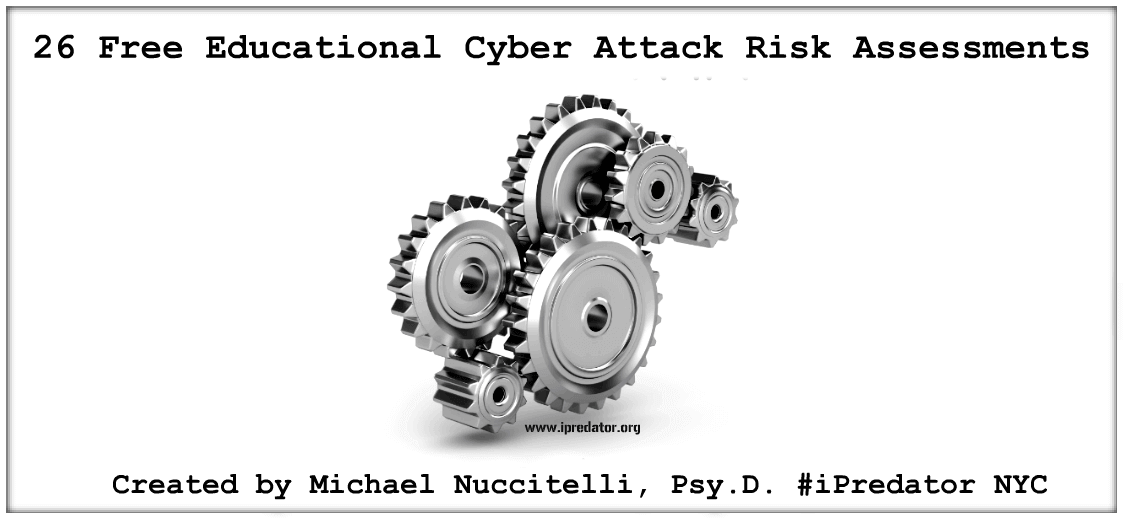
26 Free Cyber-Attack Risk Assessments
by
Dr. Nuccitelli
All of Dr. Nuccitelli’s cyber-attack risk assessments and internet safety PDF tests have been formatted and designed to work as data collection, assessment, educational and internet safety monitoring tools. Of the 26 checklists & inventories offered, the IISC tools (13 Checklists & 1 Interview) are formatted for verification and initial screening for internet safety, cyber-attack preparedness and Information and Communications Technology (ICT) weaknesses. The IPI tools (12 Inventories) are designed for inquiry, open discussion and inspection of internet safety, cyber-attack preparedness and Information and Communications Technology (ICT) vulnerabilities.
Regarding the IISC & IPI Collection, Dr. Nuccitelli specifically designed them for the primary purpose of being used as data collection and education tools. Although he spent an enormous amount of time in their development and confident of their diagnostic capacities, he did not run them through clinical trials or validity examinations as commonly conducted with psychometric testing instruments.
Dr. Nuccitelli does not falsely claim or advertise any of their checklists or inventories as being psychometric instruments with extensive reliability & validity verification analysis. However, Dr. Nuccitelli is confident his checklists & inventories were thoroughly researched and created leading to useful tools used by information security organizations, educational systems, professionals, professional organizations and families. As he and all humanity are the first generation of the Information Age, Dr. Nuccitelli is also confident all his products & services will be amended for years to come as behavioral healthcare, law enforcement & the social sciences learn more about the impact iPredators have on the health of society. A brief definition of the 26 tools is presented as follows.
Note: All internet safety themed checklists and inventories are free of charge to download, print and share. Pasted below are the links for each assessment located at this website. Click on the assessment link you would like to download. Once there, click on the “blue” file download button to save or print the PDF file. For online safety purposes, no personal information or an email address is required to download. Respectfully, Dr. Nuccitelli
IPREDATOR INVENTORY LINKS
- iPredator Probability Inventory – 330 (IPI-330)
- iPredator Probability Inventory – Adult (IPI-A)
- iPredator Probability Inventory – Business (IPI-B)
- iPredator Probability Inventory – Cyberbully (IPI-CB)
- iPredator Probability Inventory – Cyberbully Abuser (IPI-CBA)
- iPredator Probability Inventory – Cybercrime (IPI-C)
- iPredator Probability Inventory – Cyberstalking (IPI-CS)
- iPredator Probability Inventory – Educator (IPI-E)
- iPredator Probability Inventory – Internet Predator (IPI-IP)
- iPredator Probability Inventory – Pediatric (IPI-P)
- iPredator Probability Inventory – Psychologist (IPI-PSY)
- iPredator Probability Inventory – Teen (IPI-T)
IPREDATOR CHECKLIST LINKS
- Adult Internet Safety Checklist (AISC)
- Business Internet Safety Checklist (BISC)
- Cyberbully Abuser Checklist (CBAC)
- Cyberbullying Target Checklist (CBTC)
- Cybercrime Protection Checklist (CCPC)
- Cyberstalker Identification Interview (CSII)
- Cyberstalking Prevention Checklist (CSPC)
- Digital Reputation Protection Checklist (DRPC)
- Educator Internet Safety Checklist (EISC)
- Internet Safety Checklist Psychologist (ISCP)
- Online Predator Prevention Checklist (OPPC)
- Parent Cyber Safety Checklist (PCSC)
- Pediatric Internet Safety Checklist (PISC)
- Teen Internet Safety Checklist (TISC)
INTERNET SAFETY CHECKLIST COLLECTION
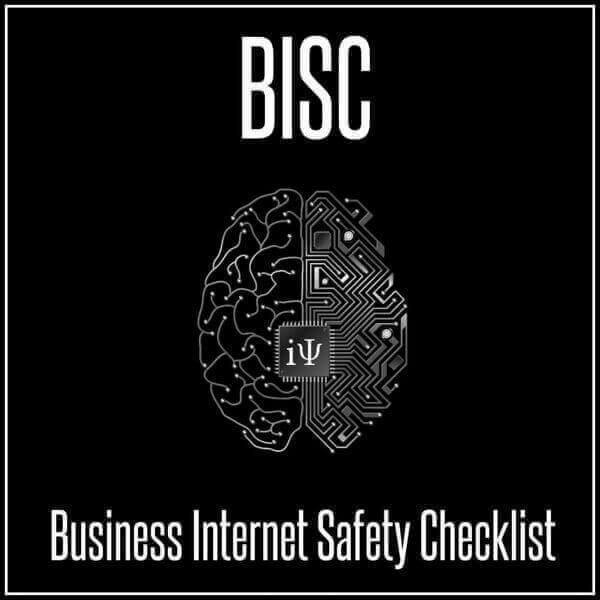
Business Internet Safety Checklist
[BISC]
Business Internet Safety Checklist (BISC): The Business Internet Safety Checklist (BISC) is a 100-item checklist designed for a business to verify, upgrade or monitor their Information and Communications Technology (ICT) safety and security practices. The BISC is a data collection tool that investigates a business’s vulnerability of being targeted, disparaged, slandered, stolen from or infiltrated by cyber criminals, disgruntled past employees/customers or nefarious corporate competitors. Related to cybercrime specific areas, the BISC focuses the business on their cyber-security breach potential, digital reputation acumen and capacity to institute internet safety and cyber security strategies.
With the rapid growth and expansion of Information and Communications Technology (ICT), all businesses will be required to allocate a part of their operating budget to both cyber security and digital reputation management. It is recommended to complete the BISC on a quarterly basis if corporate competitors or internal employee sabotage are suspected of engaging in online disparagement and/or internet defamation to the online reputation or brand(s) of the business. The BISC also addresses the growth of mobile device technology and attempts by iPredators to infiltrate their target’s mobile devices.
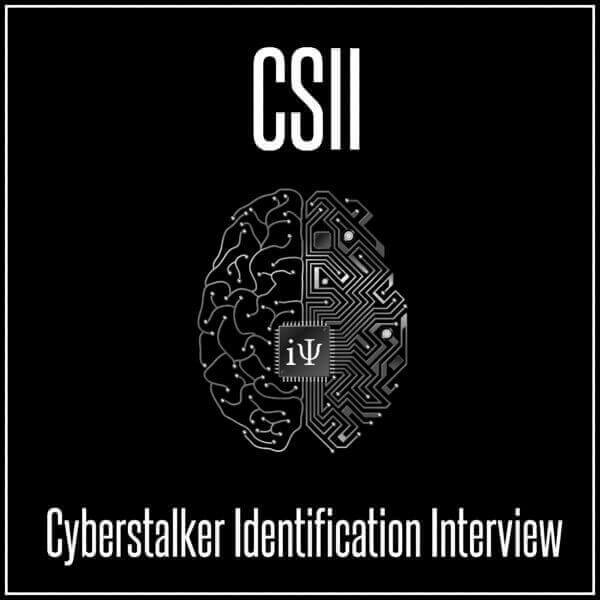
Cyber Stalker Identification Interview
[CSII]
Cyber Stalker Identification Interview (CSII): The Cyber Stalker Identification Interview (CSII) is a 75 question diagnostic and data collection tool designed to meet a three-fold purpose. The three functions include:
A. Assess the vulnerability and preparedness of a child, adolescent, adult, business or public figure of being cyber stalked and/or cyber harassed.
B. Assist law enforcement, legal professionals, parents, adults and businesses in collecting data on the identity of an unknown cyber stalker.
C. Assess the extent and skills of the cyber stalker’s tactics and the target’s Information and Communications Technology (ICT) weaknesses and high-risk behaviors the cyber stalker is attacking. For purposes of the target vulnerability estimate the CSII has been designed to investigate, the CSII combines aspects of cyber stalking, cyber harassment and cyberbullying if the target is a minor.
The CSII can also be used as a data collection template to present to authorities if a target is actively being cyberstalked. The CSII is particularly helpful to employees and consultants in charge of protecting public figures, celebrities and high-profile groups at high risk for being cyber stalked given their public exposure. The CSII also addresses the growth of mobile device technology and attempts by iPredators to infiltrate their target’s mobile devices.
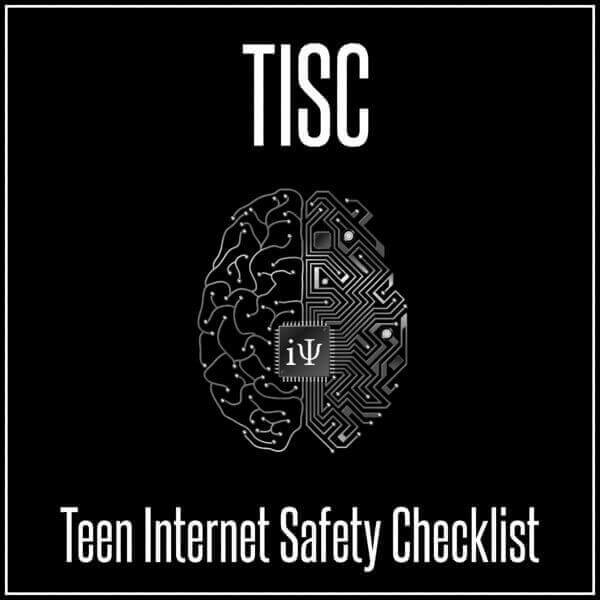
Teen Internet Safety Checklist
[TISC]
Teen Internet Safety Checklist (TISC): The Teen Internet Safety Checklist (TISC) is a 100-item education, assessment and data collection tool designed for teachers, educators and pediatric professionals related to pre-pubescent and adolescent Internet safety and responsible Information and Communications Technology (ICT) usage. The TISC is formatted in a way allowing the adolescent, an adult or both parties to complete the checklist. The TISC queries and explores areas developmentally relevant to an early adolescent, adolescent and young adult, ages 11-21.
These areas include sexuality, intimate partnerships and perceived peer group acceptance in relationship to their internet safety practices. The goal of the TISC is to educate children on their vulnerability and risk potential of being targeted by an iPredator engaged in cybercrime, cyber stalking, cyber harassment, cyber bullying or trolling for a target to sexually victimize.
In addition to a data collection and educational tool, the TISC has been designed to allow teachers, educators and pediatric professionals to interview, collect data and engage in a dialogue with children and teens on their Information and Communications Technology (ICT) practices. The factors most problematic to children and teens include inappropriate personal information disclosure, high-risk ICT behaviors and minimal iPredator awareness. The TISC investigates these areas problematic to all children and adolescents. The TISC also addresses the growth of mobile device technology and attempts by iPredators to infiltrate their target’s mobile devices.
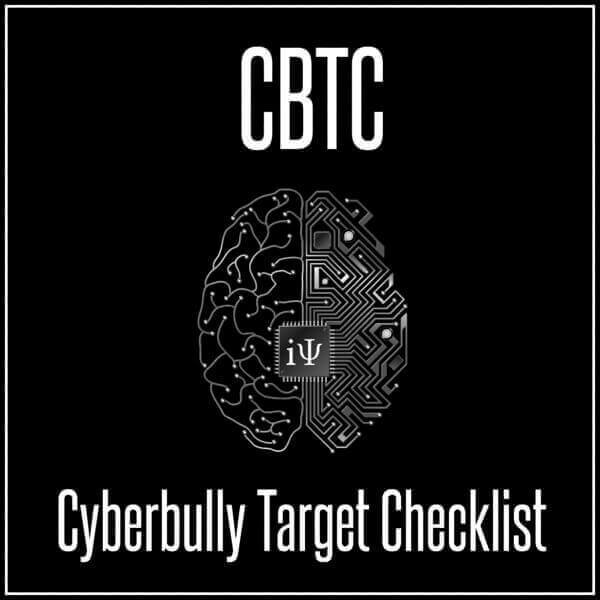
Cyber Bully Target Checklist
[CBTC]
Cyber Bully Target Checklist (CBTC): The Cyber Bully Target Checklist is a 75-item education, assessment and data collection tool designed for parents, teachers, educators and pediatric professionals on a pre-pubescent, adolescent or young adult’s vulnerability and risk potential of being targeted by a cyber bully. The CBTC queries and explores areas developmentally relevant to school aged children. The goal of the CBTC is to investigate & educate children on their vulnerability and risk potential of being targeted by a cyberbully engaged in teasing, taunting, harassment and disparagement of a target child using Information and Communications Technology (ICT).
In addition to an education, assessment and data collection tool, the CBTC has been designed to allow teachers, educators and pediatric professionals to interview, collect data and engage in a dialogue with children on their Information and Communications Technology (ICT) practices.
The CBTC combines common factors causing children and young adults to be teased, harassed and targeted by others motivated by their need for peer acceptance and feelings of domination, power and control. The CBTC can also be used to educate children and classes of students on cyberbullying prevention and intervention. Furthermore, the CBTC is helpful educating children on bullying/cyber bullying bystander dynamics and cyberbullying abuser recognition skills building. The CBTC also addresses the growth of mobile device technology and attempts by iPredators to infiltrate their target’s mobile devices.
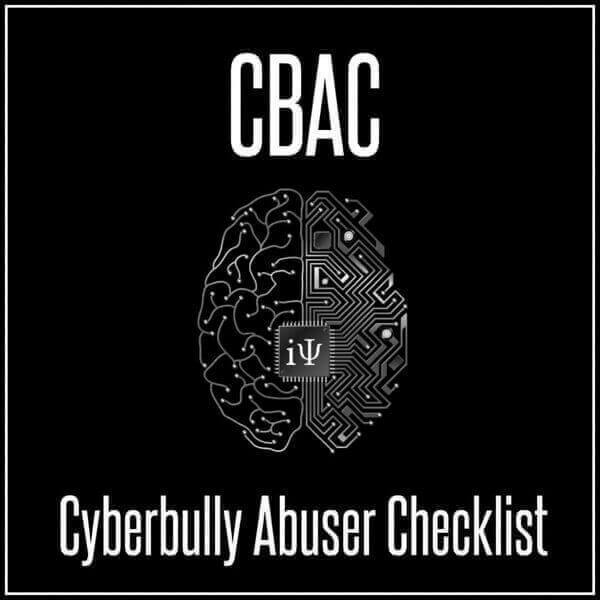
Cyber Bullying Abuser Checklist
[CBAC]
Cyber Bully Abuser Checklist (CBAC): The Cyber Bully Abuser Checklist is a 75 item education, assessment and data collection tool designed for parents, teachers, educators and pediatric professionals on a pre-pubescent, adolescent or young adult’s vulnerability and risk potential of being a cyber bully and/or engaging in cyber victimization of others.
The CBAC queries and explores areas developmentally relevant to school aged children. The goal of the CBAC is to investigate & educate children on their vulnerability and risk potential of engaging in teasing, taunting, harassment and disparagement other children using Information and Communications Technology (ICT). In addition to an education, assessment and data collection tool, the CBAC has been designed to allow teachers, educators and pediatric professionals to interview, collect data and engage in a dialogue with children on their Information and Communications Technology (ICT) practices.
The CBAC combines common factors causing children and young adults to tease, harass and target other children motivated by their need for peer acceptance and feelings of domination, power and control. The CBAC can also be used to educate children and classes of students on cyberbullying prevention and intervention. Furthermore, the CBAC is helpful educating children on bullying/cyber bullying bystander dynamics and cyberbullying target recognition skills building. The CBAC also addresses the growth of mobile device technology and attempts by iPredators to infiltrate their target’s mobile devices.
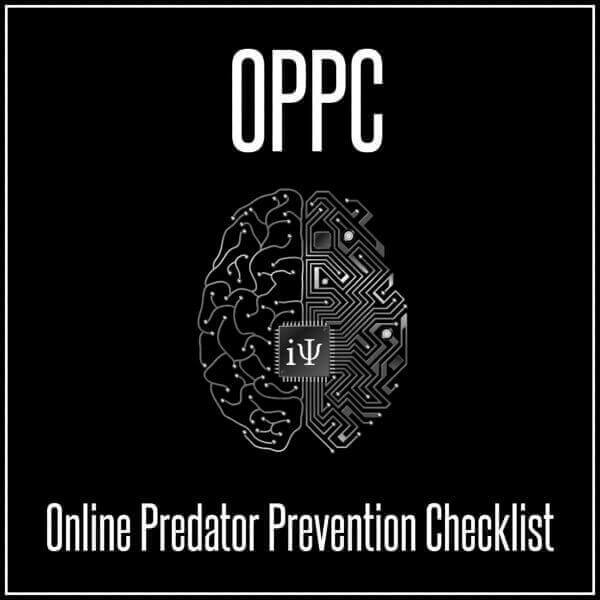
Online Predator Prevention Checklist
[OPPC]
Online Predator Prevention Checklist (OPPC): The Online Predator Prevention Checklist is a 100-item data collection & educational tool designed to educate and investigate a child, adolescent or young adult’s vulnerability and risk potential of being targeted, sexually solicited and/or victimized by online sexual predators. The OPPC investigates areas developmentally relevant to a child and young adult, ages 11-21, which can increase their levels of vulnerability. These areas include sexuality, intimate partnerships, curiosity and motivation for peer group acceptance.
A parent, primary care giver, educator or pediatric professional completes the OPPC, or if developmentally appropriate, cane be completed in tandem with the subject child. In addition to being a data collection & educational tool, the OPPC can also be used as an adjunct to allow teachers, educators and pediatric professionals interview, collect data and engage in a dialogue with children on their Information and Communications Technology (ICT) practices.
The OPPC combines common factors causing children to be sexually solicited, harassed and targeted by online sexual predators. The factors most problematic for children the OPPC explores include inappropriate personal information disclosure, high-risk ICT behaviors and minimal iPredator awareness. Furthermore, the OPPC takes into consideration the reality that most pediatric sexual victimization occurs by offenders they are familiar with, close in age and often manipulated into consenting to sexual activities. The OPPC also addresses the growth of mobile device technology and attempts by iPredators to infiltrate their target’s mobile devices.

Digital Reputation Protection Checklist
[DRPC]
Digital Reputation Protection Checklist (DRPC): The Digital Reputation Protection Checklist is a 100-item checklist designed for an Information and Communications Technology user and/or their business to monitor, protect and manage their digital reputation. Digital Reputation (a.k.a. Online Reputation) is a term used to describe the reputation of an Information and Communications Technology user or business that is disseminated online, created and sustained by peers, school, work associates, loved ones, acquaintances, consumers, competitors, adversaries, online strangers and iPredators.
This information can be positive or negative and vital to the success, growth and health of an Information and Communications Technology user or business. The DRPC is a data collection & assessment tool that investigates a business’s vulnerability of being targeted, disparaged, slandered, stolen from or infiltrated by cyber criminals, disgruntled past employees/customers or nefarious corporate competitors.
The DRPC focuses on the Information and Communications Technology user and the business’s cyber-security breach potential, digital reputation acumen and capacity to successfully institute online reputation prevention and protection strategies. With the rapid growth and expansion of Information and Communications Technology, all businesses, professionals, students and online users are now required to address both cyber security and digital reputation management. The DRPC also addresses the growth of mobile device technology and attempts by iPredators to infiltrate their target’s mobile devices.
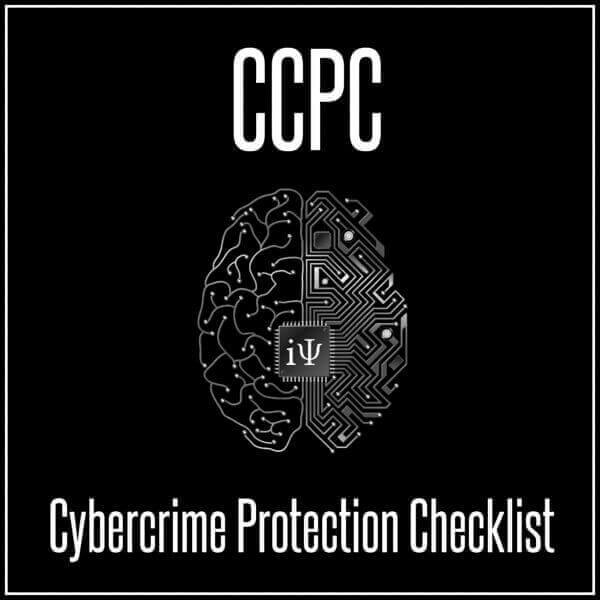
Cyber Crime Protection Checklist
[CCPC]
Cyber Crime Protection Checklist (CCPC): The Cyber Crime Protection Checklist is a 100-item checklist designed for an Information and Communications Technology user, their loved ones or business to assess their vulnerability and risk potential of being targeted. The CCPC assesses the probability of being disparaged, stolen from or infiltrated by iPredators, cyber terrorist or nefarious corporate competitors engaged in cybercriminal and/or cyber warfare activities. The CCPC also investigates personal and/or corporate vulnerability of being targeted, disparaged, slandered, stolen from or infiltrated by cyber criminals, disgruntled past employees/customers or nefarious corporate competitors. Areas examined in the CCPC include identity theft potential, personal and financial information protection, ICT safety, cyber security and security breach potential.
It is recommended to complete the CCPC on a quarterly basis and more often if known adversaries, corporate competitors or malevolent entities are suspected of engaging in possible cyber-attacks or personal/corporate disparagement. It is also strongly encouraged for businesses, professional & organizational structures and public figures to make sure their colleagues, associates and sub-contractors practice the same level of cybercrime protection. The CCPC also addresses the growth of mobile device technology and attempts by cyber criminals to infiltrate their target’s mobile devices.
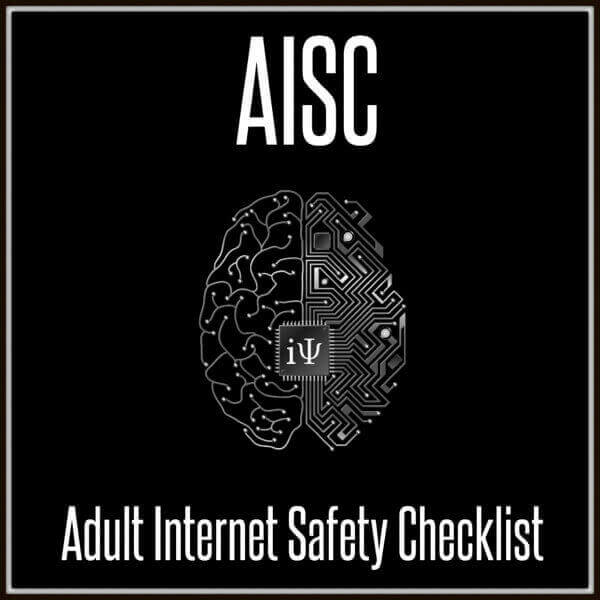
Adult Internet Safety Checklist
[AISC]
Adult Internet Safety Checklist (AISC): The Adult Internet Safety Checklist is a 100-item checklist designed for an adult Information and Communications Technology (ICT) user to verify, confirm and examine their ICT safety and security practices, online vulnerability, risk potential and cyber attack awareness. The AISC is also designed to investigate an adult’s preparedness of being assaulted, taunted, criminalized and/or victimized by iPredators based on their Information and Communications Technology (ICT) activities and level of cautious approach. As a data collection tool, the AISC can be used to investigate an adult Information and Communications Technology user’s efforts of reducing their probability of being targeted, disparaged, stolen from or infiltrated by cyber criminals, cyberstalkers, online sexual predators or those engaged in digital reputation disparagement.
The AISC enables the respondent to examine their online and ICT interactions in relationship to iPredators and the weaknesses they can focus upon to reduce the potential of successfully being cyber attacked. With the rapid growth and expansion of information technology, all Information and Communications Technology users are required to allocate time and effort employing cyber security and digital reputation tactics. The AISC also addresses the growth of mobile device technology and attempts by cyber criminals to infiltrate their target mobile devices.
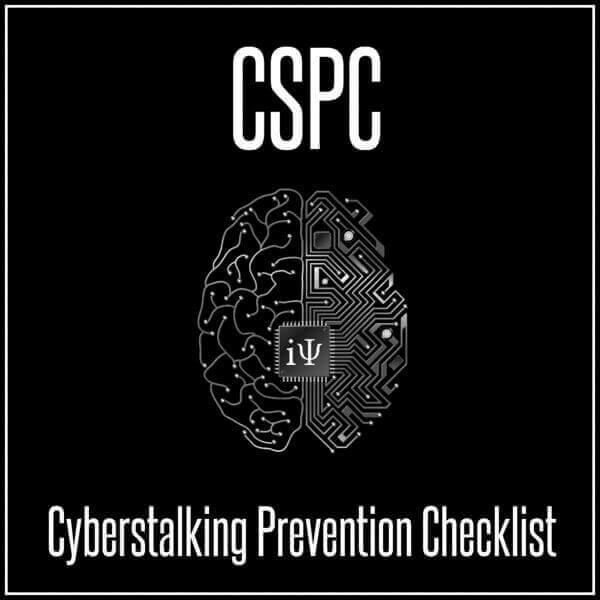
Cyber Stalking Prevention Checklist
[CSPC]
Cyber Stalking Prevention Checklist (CSPC): The Cyber Stalking Prevention Checklist is a 100-item data collection, diagnostic and educational tool designed to confirm and confirm the preparedness of an Information and Communications Technology user, business or organization of being cyberstalked and/or cyber harassed. The CSPC investigates personal and/or corporate vulnerability of being targeted, disparaged, harassed, monitored or infiltrated by cyber criminals, cyber terrorist, cyber stalkers, disgruntled ex-partners, disgruntled past employees/customers or nefarious corporate competitors.
Areas examined in the CSPC include online risk behaviors, identity theft potential, personal and financial information protection, ICT safety, cyber security and cyber stalking preparedness. An adult, business, public figure or associate of a public figure age 18+ completes the CSPC. For purposes of the cyberstalking preparedness the CSPC has been designed to investigate, this checklist combines aspects of cyber stalking, cyber harassment and cyber bullying if the subject queried is a minor.
The CSPC can also be used, as a data collection instrument to present to authorities if an Information and Communications Technology user is actively being cyber stalked or cyber harassed. The CSPC has been designed with the knowledge that cyberstalking is both a method used by assailants and a typology of offender who engages in the behavior of cyberstalking. The CSPC also addresses the growth of mobile device technology and attempts by cyber stalkers to infiltrate their target’s mobile devices.
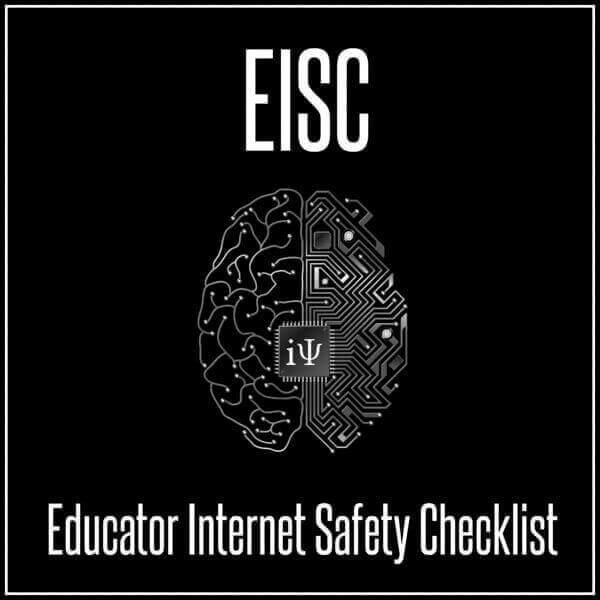
Educator’s Internet Safety Checklist
[EISC]
Educator’s Internet Safety Checklist (EISC): The Educator’s Internet Safety Checklist is a 330-item data collection, diagnostic and informational tool for educators regarding a student’s preparedness and prevention of being cyber bullied, cyber harassed, cyber stalked, sexually solicited and/or victimized by iPredators. In addition to being a data collection tool and general educational template, the EISC can also be used as an adjunct to classroom projects, prevention education plans and educator training seminars on Internet safety. The EISC is designed for educators and educational institutions working with children, adolescents and young adults ages 9-21.
The goal of the EISC is to educate children on their vulnerability and risk potential of being targeted by an iPredator engaged in cybercrime, cyberstalking, cyber harassment, cyber bullying or trolling for a target to sexually victimize. In addition to an educational tool, the EISC has been designed to allow teachers, educators and pediatric professionals to interview, collect data and engage in a dialogue with children on their Information and Communications Technology (ICT) practices. The factors most problematic for children include inappropriate personal information disclosure, high-risk ICT behaviors and minimal iPredator awareness. The EISC also addresses the growth of mobile device technology and attempts by iPredators to infiltrate their target’s mobile devices.
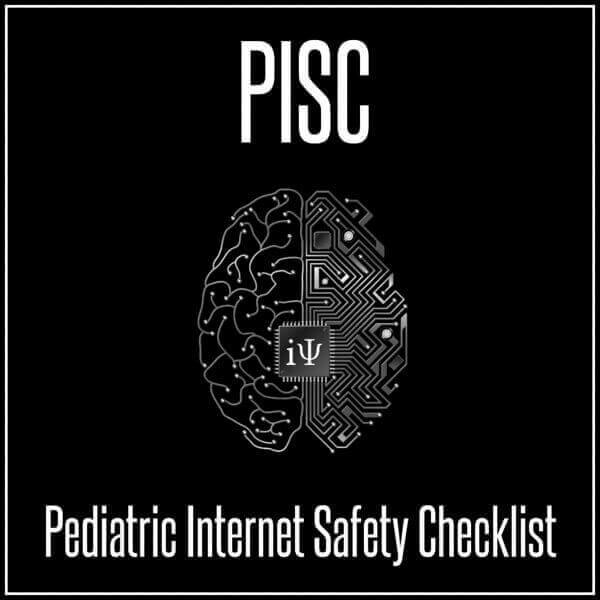
Pediatric Internet Safety Checklist
[PISC]
Pediatric Internet Safety Checklist (PISC): The Pediatric Internet Safety Checklist is a 100-item education, assessment and data collection tool designed for parents, educators and pediatric professionals on pre-pubescent and adolescent internet safety and responsible Information and Communications Technology (ICT) usage. The PISC queries and explores areas developmentally relevant to an early adolescent, adolescent and young adult, ages 11-21. The goal of the PISC is to educate children on their vulnerability and risk potential of being targeted by an iPredator engaged in cybercrime, cyber stalking, cyber harassment, cyberbullying or trolling for a target to sexually victimize.
In addition to an educational tool, the PISC has been designed to allow parents, teachers, educators and pediatric professionals to interview, collect data and engage in a dialogue with children on their Information and Communications Technology (ICT) practices. The PISC combines common factors causing children to be cyber bullied, harassed and targeted by online sexual predators. The factors most problematic for children include inappropriate personal information disclosure, high-risk ICT behaviors and minimal iPredator awareness. The PISC also addresses the growth of mobile device technology and attempts by iPredators to infiltrate their target’s mobile devices.

Internet Safety Checklist-Psychology
[ISCP]
Internet Safety Checklist Psychology (ISCP): The Internet Safety Checklist Psychology is a 330-item checklist data collection and diagnostic tool for psychiatrists, psychologists, social workers and behavioral healthcare professionals. The goal of the ISCP is to verify a child, adolescent or adult’s online preparedness and vulnerability of being cyber bullied, cyber stalked, sexually solicited, stolen from and/or victimized by iPredators. The ISCP can be used as an adjunct to individual and group therapy, prevention education training, an adjunct to intake assessments and behavioral healthcare training.
The ISCP is designed for children, adolescents and adults ages 11+. Given the rapid growth of Information and Communications Technology and social media, the ISCP is vital to behavioral healthcare professionals in their diagnosis, treatment and discharge planning of clients or patients seeking mental health and/or substance abuse treatment.
In addition to a data collection tool, the ISCP has been designed to allow behavioral healthcare professionals to engage in a dialogue with clients on their Information and Communications Technology (ICT) practices. The factors most problematic for Information and Communications Technology users involved with behavioral healthcare include inappropriate personal information disclosure, high-risk ICT behaviors, minimal iPredator awareness and psychiatric/psychological states that adversely affect their online activities. The ISPC also addresses the growth of mobile device technology and attempts by iPredators to infiltrate their target’s mobile devices.
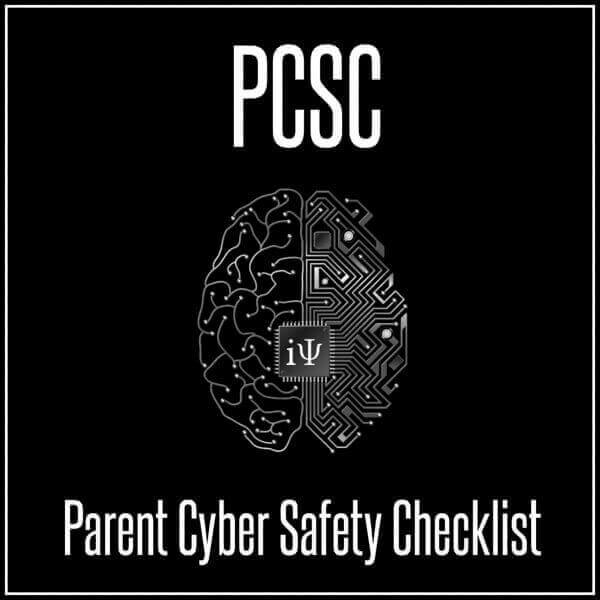
Parent Cyber Safety Checklist
[PCSC]
Parent Cyber Safety Checklist (PCSC): The Parent Cyber Safety Checklist is a 330-item education, assessment and data collection checklist designed for parents and primary caregivers on pre-pubescent and adolescent Internet safety and responsible Information and Communications Technology (ICT) usage. The PCSC is constructed for parents and primary caregivers to verify and confirm their child’s internet safety and cyber security practices are valid in preventing a cyber-attack by an iPredator. The PCSC also helps to educate children on their vulnerability and risk potential of being targeted by an iPredator engaged in cybercrime, cyber stalking, cyber harassment, cyber bullying or trolling for a target to sexually victimize. In addition to an educational tool, the PCSC has been designed to allow parents, teachers, educators and pediatric professionals to interview, collect data and engage in a dialogue with children on their Information and Communications Technology (ICT) practices.
The PCSC combines common factors causing children to be cyber bullied, harassed and targeted by online sexual predators. The factors most problematic for children include inappropriate personal information disclosure, high-risk ICT behaviors and minimal iPredator awareness. Based on a parent’s internet safety familial endeavors, the PCSC can also be used along with their child and the entire family during family discussions on cyber security. The ISPC also addresses the growth of mobile device technology and attempts by iPredators to infiltrate their target’s mobile devices.
IPREDATOR PROBABILITY INVENTORY COLLECTION
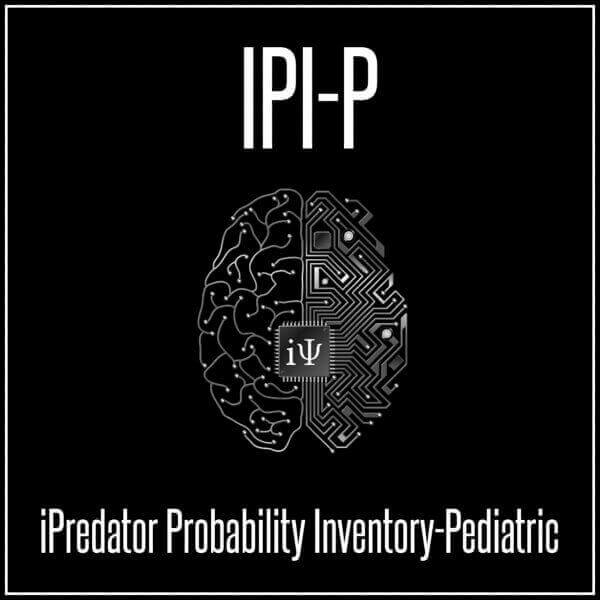
iPredator Probability Inventory – Pediatric
[IPI-P]
iPredator Probability Inventory-Pediatric (IPI-P): The iPredator Probability Inventory-Pediatric is a 110 question diagnostic, education, assessment and data collection tool designed to investigate a child, adolescent or young adult regarding their online victimization risk potential, cyber attack awareness and support system involvement. Just as all the IPI Assessment Collection inventories, the IPI-P focuses on the child’s relationship to Information and Communications Technology, their knowledge base of malevolent and nefarious users, environmental aspects influencing their Information and Communications Technology (ICT) activities and their practice of the behavioral actions necessary for Internet safety and preparedness if cyber attacked.
A parent, family member or pediatric professional completes the IPI-P. Once completed, the IPI score ranging from 0-110 represents the child, adolescent or young adult’s preparedness, vulnerability and risk potential of being targeted by an iPredator engaged in cyber bullying, cybercrime, cyber stalking, cyber harassment or trolling for targets to sexually victimize.
The IPI-P investigates these areas problematic to all Information Age children and adolescents. The long-form version of the IPI-P is the IPI-330 and designed for those seeking an exhaustive diagnostic tool with added elements. The IPI-P also addresses the growth of mobile device technology and attempts by iPredators to infiltrate their target’s mobile devices.
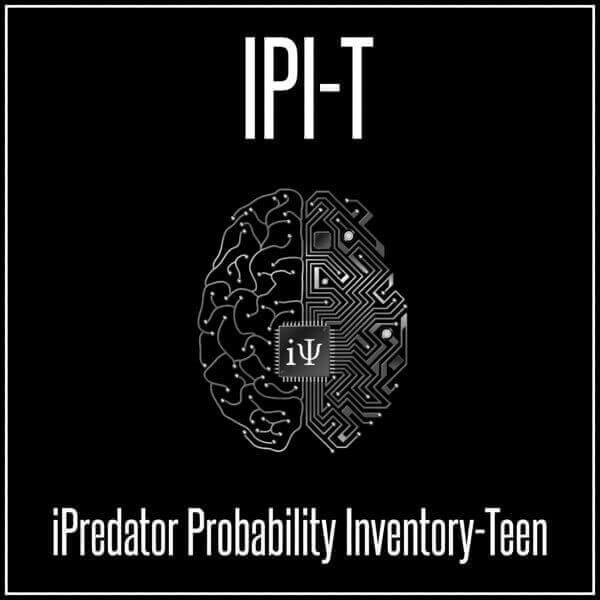
iPredator Probability Inventory-Teen
[IPI-T]
iPredator Probability Inventory-Teen (IPI-T): The iPredator Probability Inventory-Teen is a 110 statement diagnostic, education, assessment and data collection tool designed to investigate an adolescent or young adult’s online preparedness, vulnerability and risk potential of being targeted by an iPredator. This diagnostic tool is similar to the IPI-P & IPI-330, but queries areas developmentally relevant to an adolescent or young adult involving sexuality, intimate partnerships and perceived peer group acceptance.
Just as all the IPI Assessment Collection inventories, the IPI-T focuses on the adolescent’s relationship to ICT, their knowledge base of malevolent and nefarious users, environmental aspects influencing their Information and Communications Technology (ICT) activities and their practice of the behavioral actions necessary for Internet safety and preparedness if cyber attacked.
The IPI-T is completed by an adolescent or young adult ages 13-21, but can also be used by adults and educators for educational and data collection purposes. Once completed, the IPI score, ranging from 0-110, represents their preparedness, vulnerability and risk potential of being targeted by an iPredator engaged in cybercrime, cyber stalking, cyber harassment, cyber bullying or trolling for a target to sexually victimize. The IPI-T investigates the areas problematic to all Information Age children and adolescents. Furthermore, the IPI-T also addresses the growth of mobile device technology and attempts by iPredators to infiltrate their target’s mobile devices.
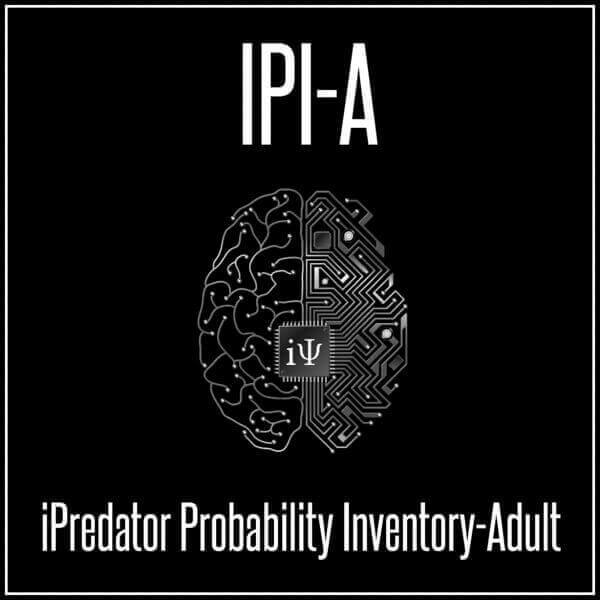
iPredator Probability Inventory-Adult
[IPI-A]
iPredator Probability Inventory-Adult (IPI-A): The iPredator Probability Inventory-Adult is a 110 question diagnostic, education, assessment and data collection tool designed to investigate an adult’s preparedness, vulnerability, risk potential and cyber attack awareness. The IPI-A is also designed to assess an adult’s preparedness of being assaulted, taunted, criminalized and/or victimized by iPredators based on their online activities and level of cautious approach.
Just as all the IPI Assessment Collection inventories, the IPI-A focuses on the adult’s relationship to ICT, their knowledge base of malevolent and nefarious users, environmental aspects influencing their Information and Communications Technology (ICT) activities and their practice of the behavioral actions necessary for Internet safety and preparedness if cyber attacked. The IPI-A is completed by an adult age 18+.
Once completed, the IPI score, ranging from 0-110, represents an adults vulnerability and risk potential of being targeted by an iPredator engaged in cybercrime, cyber stalking, cyber harassment or trolling for targets to sexually victimize. The IPI-A is also helpful to adults who are endeavoring to learn and institute effective Internet safety practices. For adults seeking to evaluate their preparedness and vulnerability of an iPredator attack, the IPI-A was constructed to address these areas. The IPI-A also addresses the growth of mobile device technology and attempts by iPredators to infiltrate their target’s mobile devices.
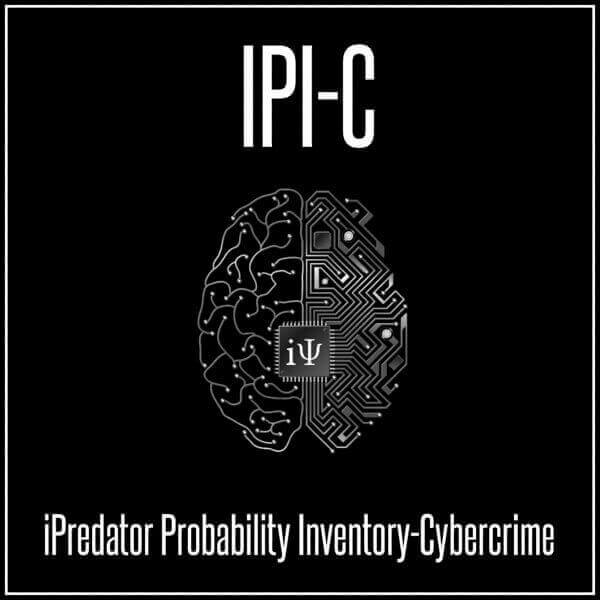
iPredator Probability Inventory-Cybercrime
[IPI-C]
iPredator Probability Inventory-Cybercrime (IPI-C): The iPredator Probability Inventory-Cybercrime is a 110 question diagnostic, education, assessment and data collection tool designed to assess and investigate an adult or business’s probability of being targeted, disparaged, stolen from or infiltrated by iPredators or nefarious corporate competitors engaged in cyber criminal activities. An adult age 18+, business owner or corporate associate familiar with the business’s health and safety completes the IPI-C.
Just as all the IPI Assessment Collection inventories, the IPI-C focuses on the adult or business’s relationship to ICT, their knowledge base of malevolent and nefarious users, environmental aspects influencing their Information and Communications Technology (ICT) activities and their practice of the behavioral actions necessary for Internet safety, cybercrime prevention and preparedness if cyber attacked.
Once completed, the IPI score, ranging from 0-110, represents the vulnerability, preparedness and risk potential of the adult or business being targeted by an iPredator engaged in cybercrime. Areas focused on in the IPI-C include identity theft, personal and financial information protection, ICT safety and cyber security. In addition to a diagnostic and data collection tool, the IPI-C can also be used to assist an Information and Communications Technology user or a business to investigate their security breach weaknesses if they have been victimized by cybercrime. The IPI-C also addresses the growth of mobile device technology and attempts by iPredators to infiltrate their target’s mobile devices.
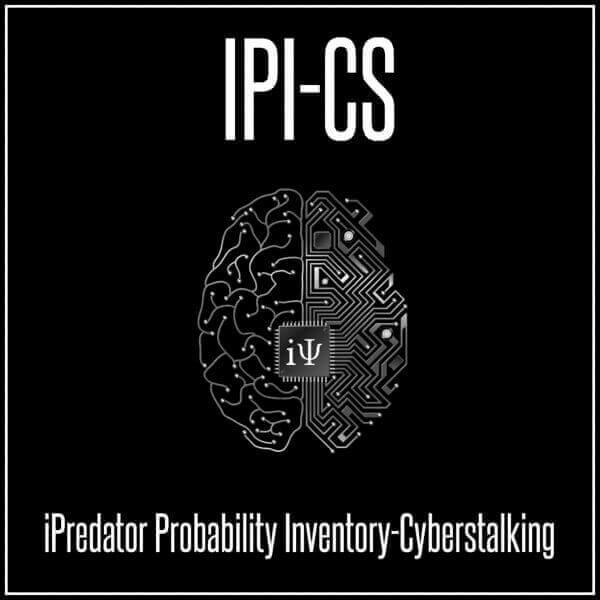
iPredator Probability Inventory-Cyber Stalking
[IPI-CS]
iPredator Probability Inventory-Cyber Stalking (IPI-CS): The iPredator Probability Inventory- Cyber Stalking is a 110 question diagnostic, education, assessment and data collection tool designed to assess the probability and preparedness of a young adult, adult or public figure of being cyber stalked. In addition to cyber stalking, the IPI-CS investigates the subject’s potential of being cyber harassed by an ex-partner, ex-associate, fan, nefarious corporate entity or pathologically driven Information and Communications Technology user.
Just as all the IPI Assessment Collection inventories, the IPI-CS focuses on the subject’s relationship to ICT, their knowledge base of malevolent and nefarious users, environmental aspects influencing their Information and Communications Technology (ICT) activities and their practice of the behavioral actions necessary for Internet safety and preparedness if cyber attacked. For purposes of the probability estimate the IPI-CS has been designed to assess, this inventory combines aspects of cyberstalking, cyber harassment and habitual online personal disparagement.
An adult, public figure or associate of a public figure age 18+ completes the IPI-CS. Once completed, the IPI score, ranging from 0-110, represents the inventory respondent’s or the subject being queried preparedness, vulnerability and risk potential of being targeted by an iPredator engaged in cybercrime, cyber stalking, cyber harassment or cyber bullying if the subject being queried is a minor. The IPI-CS can be used as both a cyber stalking prevention tool and data collection instrument if the Information and Communications Technology user or business is presently being cyber stalked. The IPI-CS also addresses the growth of mobile device technology and attempts by iPredators to infiltrate their target’s mobile devices.

iPredator Probability Inventory-Cyber Bully
[IPI-CB]
iPredator Probability Inventory-Cyber Bully (IPI-CB): The iPredator Probability Inventory-Cyber Bully is a 110-question diagnostic, education, assessment and data collection tool designed to investigate a child or adolescent’s online preparedness, vulnerability and risk potential for being cyber bullied and/or harassed. Just as all the IPI Assessment Collection inventories, the IPI-CB focuses on the child’s relationship to ICT, their knowledge base of malevolent and nefarious users, environmental aspects influencing their Information and Communications Technology (ICT) activities and their practice of the behavioral actions necessary for Internet safety and preparedness if cyber attacked.
The IPI-CB also explores parental and support system cyberbully protection and prevention tactics employed by loved ones and school officials. A parent, primary caregiver, educator or pediatric professional completes the IPI-CB for children and adolescents ages 6-17.
Once completed, the IPI score, ranging from 0-110, represents the preparedness, vulnerability and risk potential of the child becoming a cyber bully target, cyber bully abuser or cyber bully bystander. The IPI-CB can be used as both a cyber bullying prevention tool for children and a data collection instrument for parents and educators investigating cyberbullying episodes involving their child or student. The IPI-CB also addresses the growth of mobile device technology and attempts by iPredators to infiltrate their target’s mobile devices.

iPredator Probability Inventory-Cyber Bully Abuser
[IPI-CBA]
iPredator Probability Inventory-Cyber Bully Abuser (IPI-CBA): The iPredator Probability Inventory-Cyber Bully Abuser is a 110 question diagnostic, education, assessment and data collection tool designed to investigate a child or adolescent’s online probability and potential to intimidate, humiliate and taunt other children engaging in online harassment and cyber bullying. A parent, primary caregiver and school official or pediatric professional complete the IPI-CBA for children, and adolescents ages 6-17.
Just as all the IPI Assessment Collection inventories, the IPI-CBA focuses on the child’s relationship to ICT, their knowledge base of malevolent and nefarious users, environmental aspects influencing their Information and Communications Technology (ICT) activities and their practice of the behavioral actions necessary for appropriate online activities.
Once completed, the IPI score, ranging from 0-110, represents the vulnerability and risk potential of the child becoming a cyber bully abuser, both cyberbully target and abuser or cyberbully bystander. The IPI-CBA can be used as both a cyber bullying assessment tool for children and a data collection instrument for parents and educators investigating cyber bullying episodes involving their child or student. Similar to the IPI-CB, the IPI-CBA investigates the knowledge and understanding parents and/or educators have relevant to investigating the cyber bully abuser. The IPI-CBA also addresses the growth of mobile device technology and attempts by iPredators to infiltrate their target’s mobile devices.
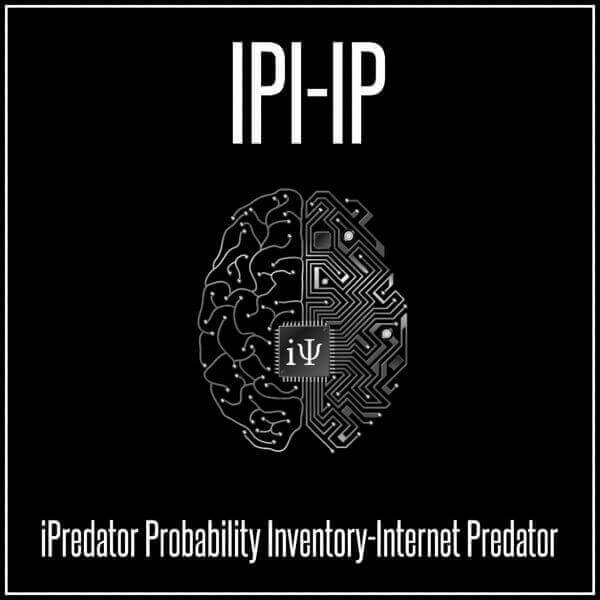
iPredator Probability Inventory – Internet Predator
[IPI-IP]
iPredator Probability Inventory-Internet Predator [IPI-IP]: The iPredator Probability Inventory-Internet Predator is a 110-question data collection, diagnostic and educational tool designed to assess a child, adolescent or young adult’s preparedness, vulnerability and risk potential of being targeted, sexually solicited and/or victimized by online sexual predators. A parent, primary caregiver, school official or pediatric professional completes the IPI-IP. In addition to being a diagnostic tool and inventory, the IPI-IP can also be used as an adjunct to a mental health and/or forensic assessment.
The IPI-IP is designed for children, adolescents and young adults ages 6-21. Just as all the IPI Assessment Collection inventories, the IPI-IP focuses on the child’s relationship to ICT, their knowledge base of malevolent and nefarious users, environmental aspects influencing their Information and Communications Technology (ICT) activities and their practice of the behavioral actions necessary for internet safety and preparedness if cyber attacked.
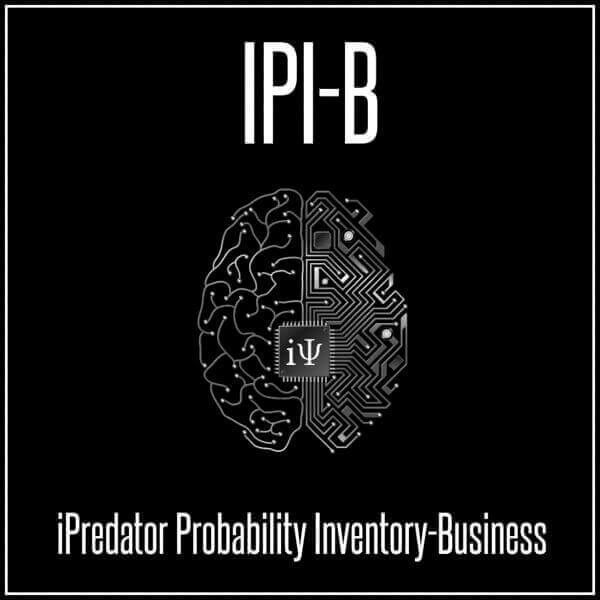
iPredator Probability Inventory-Business
[IPI-B]
iPredator Probability Inventory-Business (IPI-B): The iPredator Probability Inventory-Business is a 110 questions diagnostic, education, assessment and data collection tool designed to assess a business’s vulnerability of being targeted, disparaged, slandered, stolen from or infiltrated by iPredators or nefarious corporate competitors. Related to cybercrime specific areas, the IPI-B also assesses a business’s cyber-security breach potential, digital reputation acumen and capacity to institute Internet safety and cyber security strategies. A business owner, employee or consultant familiar with the business’s Information and Communications Technology (ICT) health & safety completes the IPI-B.
Just as all the IPI Assessment Collection inventories, the IPI-B focuses on the business’s relationship to ICT, their knowledge base of malevolent and nefarious users, environmental aspects influencing their Information and Communications Technology (ICT) activities and their practice of the behavioral actions necessary for Internet safety and preparedness if cyber attacked.
Relevant to businesses, the IPI-B addresses and investigates the businesses understanding of digital reputation and digital reputation management. Upon completion of the IPI-B, the IPI score ranges from 0-110 and represent the vulnerability and risk potential if targeted by an iPredator or nefarious corporate competitor engaged in cyber criminal activity and/or corporate disparagement. The IPI-B is a helpful diagnostic and educational tool for employees and consultants related to the business. The IPI-B also addresses the growth of mobile device technology and attempts by iPredators to infiltrate their target’s mobile devices.

iPredator Probability Inventory-Educator
[IPI-E]
iPredator Probability Inventory-Educator (IPI-E): The iPredator Probability Inventory-Educator is a 330 question data collection, diagnostic and informational tool for educators regarding a student’s online risk potential and vulnerability of being targeted, cyber bullied, cyber stalked, sexually solicited and/or victimized by iPredators. In addition to being a data collection tool and general screening exam, the IPI-E can also be used as an adjunct to classroom projects, prevention education plans and educator training seminars on Internet safety.
The IPI-E is designed for educators and educational institutions working with children, adolescents and young adults ages 9-21. Just as all the IPI Assessment Collection inventories, the IPI-E focuses on a child and/or students relationship to ICT, their knowledge base of malevolent and nefarious users, environmental aspects influencing their online activities and their practice of the behavioral actions necessary for Internet safety and preparedness if cyber attacked.
Upon completion of the IPI-E, the IPI score ranges from 0-330 and represents the preparedness, probability and risk potential of the student being a targeted by an iPredator engaged in cyberbullying, cybercrime, cyberstalking, cyber harassment or trolling for targets to sexually victimize. The IPI-E is a 330-question inventory segmented into 11 categories relevant to all Information and Communications Technology users and can be conducted all at once or used in parts focusing on the educators’ goals. The IPI-E also addresses the growth of mobile device technology and attempts by iPredators to infiltrate their target’s mobile devices.

iPredator Probability Inventory-Psychologist
[IPI-PSY]
iPredator Probability Inventory-Psychologist (IPI-PSY): The iPredator Probability Inventory- Psychologist is a 330 question data collection, educational and diagnostic tool for psychiatrists, psychologists, social workers and behavioral healthcare professionals regarding a child, adolescent or adult’s Information and Communications Technology (ICT) preparedness, probability and vulnerability of being cyber bullied, cyber stalked, sexually solicited, stolen from and/or targeted by iPredators. The IPI-PSY can also be used as an adjunct to individual and group therapy, prevention education training, an adjunct to intake assessments and behavioral healthcare training. The IPI-PSY is designed for children, adolescents and adults ages 9+.
Upon completion of the IPI-PSY, the IPI score ranges from 0-330 and represents the preparedness, vulnerability and risk potential of the subject being targeted by an iPredator and/or possibly being an iPredator. Just as all the IPI Assessment Collection inventories, the IPI-PSY focuses on an Information and Communications Technology user’s relationship to ICT, their knowledge base of malevolent and nefarious users, environmental aspects influencing their Information and Communications Technology (ICT) activities and their practice of the behavioral actions necessary for Internet safety and preparedness if cyber attacked.
The IPI-PSY questions are formatted to investigate the knowledge base, environmental aspects and behavioral actions necessary for Internet safety and preparedness if cyber attacked. The IPI-PSY is a 330-question inventory segmented into 11 categories relevant to all Information and Communications Technology users and can be conducted all at once or used in parts focusing on the behavioral healthcare professional goals or areas of assessment. The IPI-PSY also addresses the growth of mobile device technology and attempts by iPredators to infiltrate their target’s mobile devices.

iPredator Probability Inventory-330
[IPI-330]
iPredator Probability Inventory-330 (IPI-330): The iPredator Probability Inventory-330 is a 330 question diagnostic, education, assessment and data collection tool designed to investigate a 6-21 year-old child, adolescent or young adult regarding their online victimization risk potential, cyber attack awareness and support system involvement. A parent, educator, family member or pediatric professional completes the IPI-330. Just as all the IPI Assessment Collection inventories, the IPI-330 focuses on a child and/or students relationship to ICT, their knowledge base of malevolent and nefarious users, environmental aspects influencing their Information and Communications Technology (ICT) activities and their practice of the behavioral actions necessary for Internet safety and preparedness if cyber attacked.
Once completed, the respondent tabulate their score, ranging from 0-330 and represents the child, adolescent or young adult’s risk potential and vulnerability of being targeted by an iPredator engaged in cyber bullying, cybercrime, cyber stalking, cyber harassment or trolling for targets to sexually victimize. The short-form version of the IPI-330 is the IPI-P designed for those seeking a concise diagnostic tool that can be completed in 1/3 of the time.
As the inventory name states, the IPI-330 is a 330 question inventory segmented into 11 categories relevant to all Information and Communications Technology users and can be conducted all at once or used in parts focusing on the parent or educator’s goals and strategies. The IPI-330 also addresses the growth of mobile device technology and attempts by iPredators to infiltrate their target’s mobile devices.
IPREDATOR INVENTORY LINKS
- iPredator Probability Inventory – 330 (IPI-330)
- iPredator Probability Inventory – Adult (IPI-A)
- iPredator Probability Inventory – Business (IPI-B)
- iPredator Probability Inventory – Cyberbully (IPI-CB)
- iPredator Probability Inventory – Cyberbully Abuser (IPI-CBA)
- iPredator Probability Inventory – Cybercrime (IPI-C)
- iPredator Probability Inventory – Cyberstalking (IPI-CS)
- iPredator Probability Inventory – Educator (IPI-E)
- iPredator Probability Inventory – Internet Predator (IPI-IP)
- iPredator Probability Inventory – Pediatric (IPI-P)
- iPredator Probability Inventory – Psychologist (IPI-PSY)
- iPredator Probability Inventory – Teen (IPI-T)
IPREDATOR CHECKLIST LINKS
- Adult Internet Safety Checklist (AISC)
- Business Internet Safety Checklist (BISC)
- Cyberbully Abuser Checklist (CBAC)
- Cyberbullying Target Checklist (CBTC)
- Cybercrime Protection Checklist (CCPC)
- Cyberstalker Identification Interview (CSII)
- Cyberstalking Prevention Checklist (CSPC)
- Digital Reputation Protection Checklist (DRPC)
- Educator Internet Safety Checklist (EISC)
- Internet Safety Checklist Psychologist (ISCP)
- Online Predator Prevention Checklist (OPPC)
- Parent Cyber Safety Checklist (PCSC)
- Pediatric Internet Safety Checklist (PISC)
- Teen Internet Safety Checklist (TISC)

Michael Nuccitelli, Psy.D.
Michael Nuccitelli, Psy.D. is a NYS licensed psychologist, cyberpsychology researcher and online safety educator. In 2009, Dr. Nuccitelli finalized his dark side of cyberspace concept called iPredator. Since 2010, he has advised those seeking information about cyberbullying, cyberstalking, cybercriminal minds, internet addiction and his Dark Psychology concept. By day Dr. Nuccitelli is a practicing psychologist, clinical supervisor and owner of MN Psychological Services, PLLC. After work and on the weekends, he volunteers helping online users who have been cyber-attacked. Dr. Nuccitelli’s is always available to interested parties and the media at no cost. This website and everything created by Dr. Nuccitelli is educational, free and public domain.